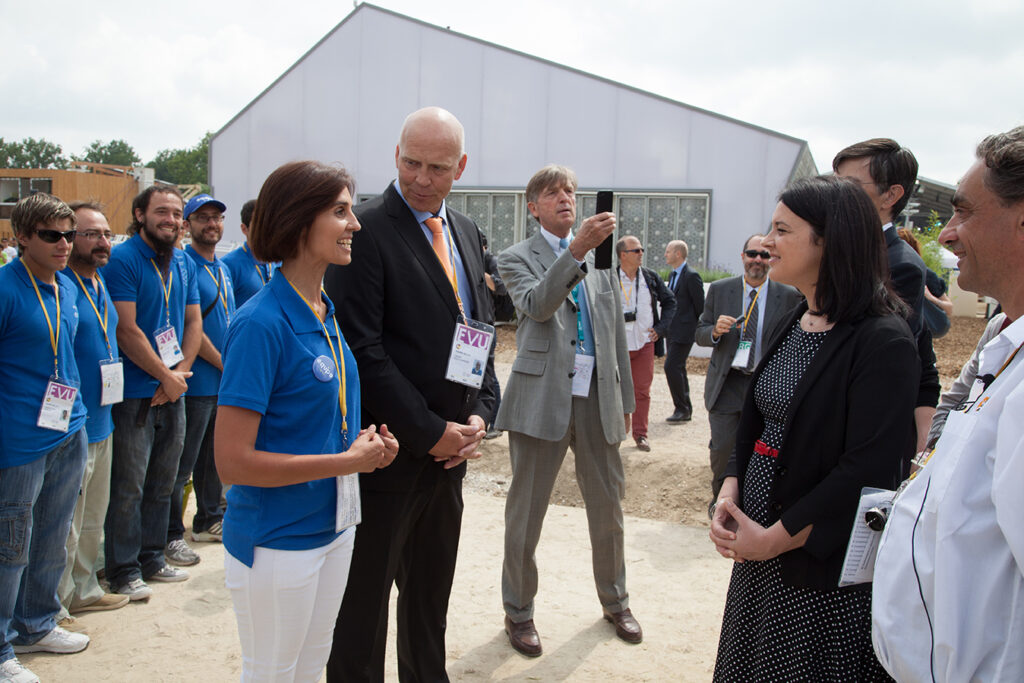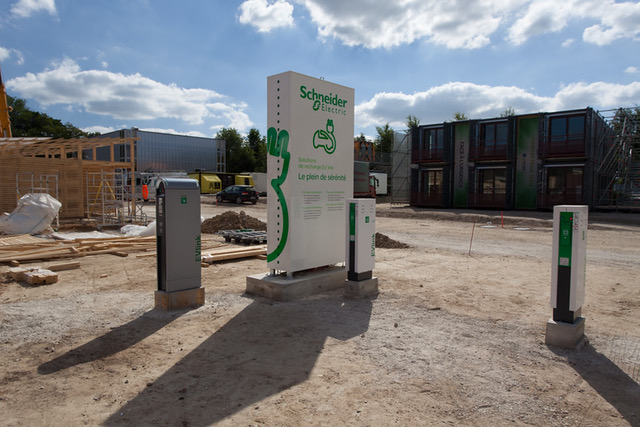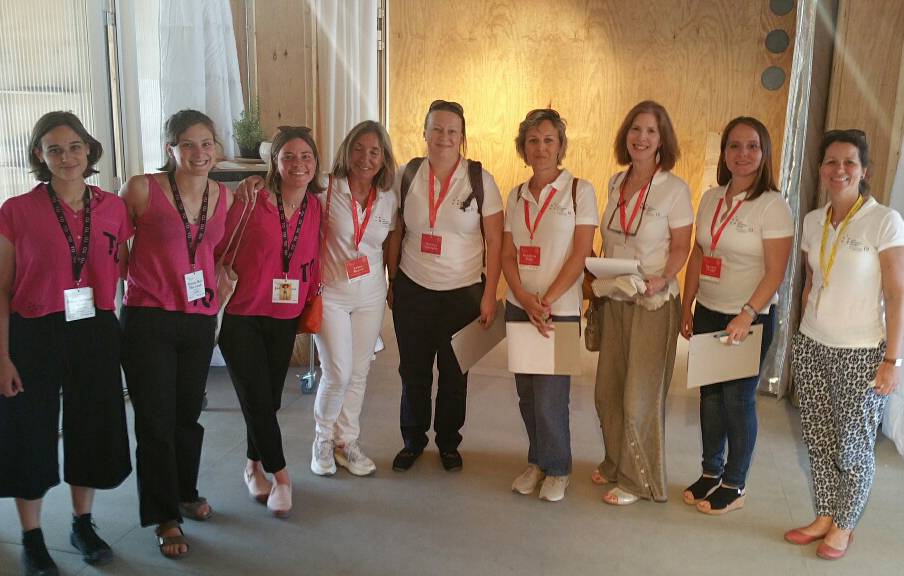Linda Silverman (third woman from the right), former director of the U.S. Department of Energy’s Solar Decathlon, shares insights on the SD experience.
Nothing in my 30+ year clean energy and climate change career has touched me as much as the Solar Decathlon. Since I first volunteered and attended the first Solar Decathlon in Washington, DC in 2002, I’ve been hooked on the entire experience – the inspiring and committed students, the public engagement of a large demonstration of student-designed and built solar-powered houses, the integration with the private sector, and the connections made in the education sphere. I was also lucky enough to be the Director of the US Department of Energy’s Solar Decathlon until my retirement in October 2018.
students as future leaders & professionals
Through the eight Solar Decathlons I’ve been to in the US, Europe and China, I and everyone I encountered were blown away by the ingenuity, resourcefulness, expertise and commitment of the students involved. These students spend two or more years working on the design and building of their houses, and are eager to share their knowledge and experience with visitors. I’ve been present when senior leaders in corporations, governments and non-profit organisations have engaged with students, and they are all equally inspired and educated. I’ve even witnessed the ‘ah hah’ moments that draw these corporations and others to immediately want to hire these students who are using fresh eyes to conquer difficult and technical design challenges. I’ve also seen the dazzled looks of middle school kids, as they meet these Decathlete role models, and connect this experience with what they may want to do and study as they grow up. Student Decathletes get the experience of having pillars of industry and local and national leaders engaging them in peer to peer discussions about technology and design, leading all to recognise that we’ll be okay if these kids are our future leaders.
I’ve even witnessed the ‘ah hah’ moments that draw these corporations and others to immediately want to hire these students who are using fresh eyes to conquer difficult and technical design challenges.
Participating students reap so many personal benefits by learning from those from other parts of the country or world, and just having fun in the lead up to and at the event. Pumpkin carving, soccer matches, eating meals, hanging out before or after public hours, or at the dinner parties that are part of the Competition… students have cited how much they loved getting to know each other by sharing stories about their Team trials and tribulations.
Former Decathletes shape a large network linked to the Competition, including the Solar Decathlon Alumni Association on LinkedIn. From a workforce perspective, the US Department of Energy’s retroactive evaluation study has shown a huge benefit to these students for working on this long-term, multidisciplinary project. Students have indicated how unique and beneficial an experience it is to their education and careers, since they rarely get to work across university departments on such a large-scale project.

public engagement
The public aspect of each international Solar Decathlon chapter is infectious. There are Solar Decathlon groupies that attend every Competition worldwide to volunteer or simply visit the houses and engage with the students. At every Solar Decathlon, there are architects, energy specialists, and other industry folks who get ideas of how to design and/or market new or adapted technologies. Regular folks and families that attend have a lift in their step as they visit these attractive houses, engage knowledgeable and inspiring student Decathletes, and learn about innovative design and energy technologies. At the Solar Decathlon I ran in Denver in 2017, an amazing number of people told me how they wanted to live in a Solar Decathlon house (or one like it). The air of enthusiasm is palpable at every Solar Decathlon I’ve attended.
benefits to universities
Participating universities have found the Solar Decathlon to be a great way to inject real-life experience in their students’ education. Nothing is as robust a training ground as having to deal with the ups and downs of a complicated project, and learning how to overcome obstacles. This has been cited by several universities, who have proudly used Solar Decathlon in their marketing to demonstrate why prospective students should attend such a forward-thinking, innovative university. Faculty that supports student Teams are to be especially commended for helping the Teams realise such a difficult, but rewarding, experience.
unique opportunity for sponsors
Private sector sponsors of the Solar Decathlon tend to walk away from this experience proud of their organisations’ involvement, not to mention the opportunity to market to those in attendance in person or online. Sponsors may offer technologies or equipment to Teams, provide funding to the event organisation, and/or participate in an accompanying exposition that offers them access to attendees. It is prestigious to be associated with the Solar Decathlon.

advice to future host cities
As the Solar Decathlon Europe SDE23 Call for Cities is in full swing, it is safe to say that I’ve never met a host city representative that regretted hosting a Solar Decathlon. I have, however, encountered those that regretted not doing more to galvanise attention prior to the event! In addition to a competition, the Solar Decathlon is a major event. Given that a key metric of success is attendance, it behooves host cities to get involved early in a sustained way, with attention to marketing the event to local press, potential sponsors and key constituencies to publicise and foster enthusiasm for the event. There are a myriad of details that a first time host could never appreciate or anticipate, so relying on best practices from previous events, by experienced organisers, will pay huge dividends.
The pride with which host cities leave this event is immeasurable, especially if it results in thousands and thousands of visitors who leave educated about innovative design and inspired by student participants to change their household energy behavior. While this benefits homeowners, who will save money as they save energy, it will also pay dividends for the city that reduces its greenhouse gas footprint, while getting kudos for having the foresight to host the Solar Decathlon. Host cities enjoy the benefits and notoriety that comes when foreign leaders, well-known people, and a ton of tourists and locals visit the site.
There is nothing that can explain the Solar Decathlon short of attending one. If you’re thinking about hosting the SDE23 or participating in it as a university Team, I encourage you to attend a Solar Decathlon Competition anywhere it is being held. It is exiting to see how the Solar Decathlon continues to evolve and expand in Europe, and across all continents. I can’t wait to visit the next one – wherever it takes place!
Written by Linda Silverman
Linda Silverman retired from the US Department of Energy after 30 years of working on clean energy and climate change. Her last post was as Director of the US Solar Decathlon, and oversaw the 2017 Solar Decathlon. She sits on the SDE Council of Experts and was a Jury member for the SDE21 Call for Cities. Linda also sat on the Jury for the contest in Communication & Social Awareness at the SDE19 in Szentendre, Hungary. For more perspectives on her career and life, visit her blog at: https://lsinsights. com/blog/

